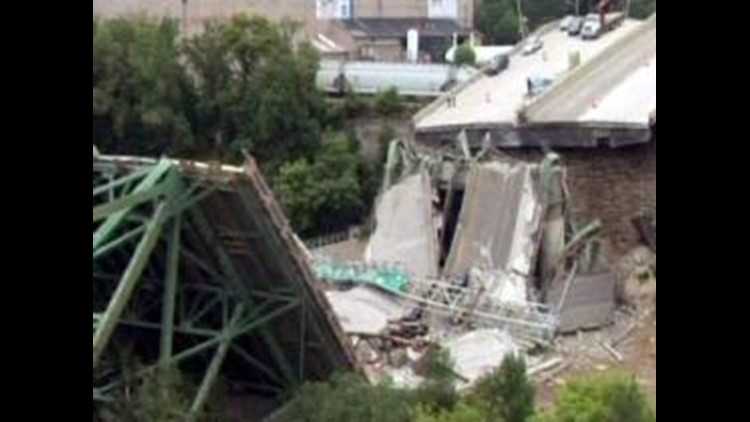Federal safety investigators on Thursday pinpointed steel plates in a main truss as the locationwhere the deadly collapse of a Minneapolis bridge last year began.
National Transportation Safety Board investigators said the bridge collapse was unavoidable,once the U-10 steel gusset plates failed due to a serious design flaw. They also ruled outcorrosion and pre-existing cracking as factors.
A two-day board hearing now under way quickly focused on the U-10 gusset plates of the I-35Wbridge. The NTSB as far back as January had identified design flaws in the plates as a criticalfactor in the collapse.
The bridge shuddered and then tumbled into the Mississippi River on Aug. 1, 2007 duringevening rush hour, killing 13 and injuring 145.
A final ruling is expected near the end of a two-day hearing at which NTSB investigators wereto discuss what they have learned since the accident - a harrowing event seen by many as a wake-upcall for a nation that had neglected its infrastructure for too long.
Democrats in Minnesota heaped criticism on the state's Republican governor, Tim Pawlenty.Democrats in Congress said the accident showed the nation's roads and bridges were crumbling.
An interim NTSB report in January cited a design error as the likely culprit for the collapseof the 40-year-old bridge: 16 fractured gusset plates. The plates, components that helped connectsteel beams, were designed at only half the required thickness.
At the time, safety board chairman Mark Rosenker called that design error a "critical factor"in the collapse. He also said there was little chance that state bridge inspectors would havenoticed undersized gusset plates.
Pawlenty took that as a measure of vindication because the initial focus had been on hisadministration's program for maintaining bridges.
Rosenker's comments enraged Rep. Jim Oberstar, a Minnesota Democrat who chairs the HouseTransportation Committee. Oberstar argued that the early pronouncement commits the safety board toa finding that might not bear out with further investigation.
Following the January report, internal NTSB memos have focused on the gusset plates and theweight of construction materials on the bridge for a resurfacing project at the time of thecollapse.
But even if the NTSB excludes other potential causes, such as cracking, corrosion or otherwear, pressure will remain on states to ramp up maintenance and inspections.
"Regardless of the final determination on that case, it brought to people's attention thefact that our infrastructure is aging," said Greg Cohen, president of the American Highway UsersAlliance, an advocacy group representing a wide range of motorists.
"No state wants to be the next state that this happens to," said Cohen.
During his campaign for the White House, President-elect Barack Obama cited the Minneapolisbridge collapse and called for spending more on the nation's crumbling highways, bridges andtunnels.
In July, the House passed legislation authorizing an additional $1 billion next year torebuild structurally deficient bridges on the national highway system. The bill would also requirestates to come up with repair plans for troubled bridges.
The Senate has yet to act on the bill. If no action is taken during a lame-duck session thatstarts next week, lawmakers would have to start anew on the legislation in January.
NTSB: Design Errors Factor In Bridge Collapse
Federal safety investigators pinpoint steel plates in a main truss as the location where the deadly collapse of a Minneapolis bridge last year began.



